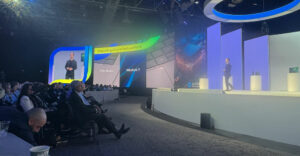
Motorola Mobility has introduced a desktop all-in-one computer running the Android operating system. The Cloud Broadband is being launched in China in partnership with WASU Digital Group.
The device is being touted to Chinese consumers as a combination of an HD digital TV with live and on-demand capability, and a touchscreen tablet/PC running Android, according to the Google Translate version of the Chinese text on the product’s Chinese launch page.
Motorola is offering the device with access to services from Chinese cable TV and digital broadcasting operator China Digital Media.
Snappy Processor
The Motorola Cloud Broadband runs on a Freescale i.MX53 processor, which is based on an ARM Cortex A8 1 GHz core.
It has 1 GB of DDR RAM and 4 GB of NAND flash memory.
The Motorola Cloud Broadband runs Android 2.3.4 and has an 18.5-inch LED display with a resolution of 1366 x 768 pixels. It’s claimed to be a TV and video client and be integrated with a variety of gadgets.
Say What, Now?
The Cloud Broadband’s claimed plethora of capabilities has analysts puzzled.
“This looks more like an Androidall-in-one (AIO) computer or large or fixed device than a connected TV,” Michael Inouye, a senior analyst at ABI Research, told TechNewsWorld.
The Cloud Broadband ships with a wireless keyboard and mouse, and the 18.5-inch screen “better suits a computing arrangement than a TV, although it could be positioned as a tabletop TV, perhaps in the kitchen,” Inouye continued. “It also seems to leverage cloud services more than traditional TV content, and I think the tie-in with China Digital TV Media gives it the TV flavor.”
“Given the increasing convergence of all consumer electronic devices, it’s hard to define something in a clean form nowadays,” Jia Wu, a research director at Strategy Analytics, remarked. “In my opinion, it is an Android smart TV with a more intimate experience, meaning closer interaction between the user and the screen.”
The Cloud Broadband “is really a convergence of PCs, TVs and smartphones,” Wu told TechNewsWorld. “TCL and Tencent also announced a similar product called “iCE Screen” lately.”
iCE Screen, described as the world’s first large-screen mobile intelligent cloud product, was demoed in August at IFA 2012.
Motorola Mobility did not respond to our request to elaborate.
Potential Markets
The Cloud Broadband is being offered in China but is likely to also be shipped to Hong Kong and Taiwan, ABI’s Wu suggested. He wouldn’t completely rule out the possibility of the device’s being offered in the United States, but “Motorola is clearly using the Chinese market to test the waters.”
However, Inouye doesn’t think the Cloud Broadband will be offered in the US because “computer ownership is high, and Android for many would be too limited as a full computing platform.”
Further, in the US, “it would gain little traction and be a difficult sell,” Inouye remarked. “Recall the Verizon Hub, which was a media phone, but sought to aggregate a lot of functions in one small screened device and it failed.”
Another Google Foot in the Door?
The question of whether or not Motorola is acting as a front in yet another attempt by Google to break into the burgeoning home entertainment market has been raised.
Google “has a number of ‘ins’ into the home entertainment market, [but] it still has a ways to go,” ABI’s Inouye said. “Google TV still has UI and content issues. The Nexus Q was priced way too high, kudos to Google for pulling it before its launch.”
Still, it’s unlikely that the Cloud Broadband is a covert attack on the home entertainment market from Google because “Google just bought Motorola and products like this have to be in planning for a year and a half,” Bob O’Donnell, a program vice president at IDC, said. “I think this was under way well before the purchase.”






















































